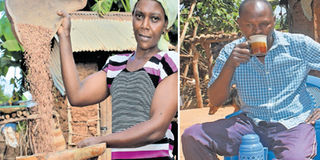Sorghum ‘tea’ a new sensation

Christine Mutindi (left) winnows sorghum in her farm in Makueni, and (right) a man drinks tea made using sorghum. The beverage is popular with residents of Tuliamni and Mbumbuni locations in Mbooni constituency, and it is spreading to other areas as word on its benefits spreads. PHOTOS | PIUS MAUNDU | NMG
What you need to know:
- Mutindi does not sell her sorghum for beer-making. She is among a handful of residents who are championing a new use of sorghum — making ‘tea’.
- The tea is made from flour obtained from roasted sorghum grains. Serendo, an improved sorghum variety that thrives in arid and semi-arid regions, is the most suitable variety for making the sorghum beverage.
- Mutindi makes Sh4,000 on a good day by selling the beverage made from a kilo of the flour during market days or farmers’ field days.
- Though the programme ended in 1996, International Crops Research Institute for Semi-Arid Tropics (ICRISAT) has recently rolled out a new one in the county.
Tucked in a man-made forest, Christine Mutindi’s farmland resembles any other on the outskirts of Mbumbuni township in Makueni County.
The farm hosts sorghum, a crop that has turned out to be the new gold in semi-arid areas, thanks to its drought-resistant quality and ready market from brewers.
However, Mutindi does not sell her sorghum for beer-making. She is among a handful of residents who are championing a new use of sorghum — making ‘tea’.
A Seeds of Gold team finds her winnowing the grain. “Over the years, we have been using sorghum flour to make porridge or ugali after blending it with maize flour. But we have now learnt to use it to make ‘sorghum tea’, which we locally call Kyai kya muvya,” she says.
The tea is made from flour obtained from roasted sorghum grains. Serendo, an improved sorghum variety that thrives in arid and semi-arid regions, is the most suitable variety for making the sorghum beverage.
“To make the tea, we start with sorting grains and roasting them on a pan until they turn golden brown. We then grind them into fine flour on a traditional grinding stone. The flour is then used to make the tea,” explains Mutindi.
One adds a spoonful of the flour to a cup of hot water mixed with milk, stirs and sieves out the particles to end up with a perfect beverage that has the same physical features as tea.
Mutindi makes Sh4,000 on a good day by selling the beverage made from a kilo of the flour during market days or farmers’ field days.
A cup of the beverage goes for Sh50. Besides the curious customers, the beverage is highly suitable for those who have been barred from taking tea for medical reasons.
It is also popular with Seventh Day Adventist communities, who do not take tea or coffee and some of whom cannot afford soya.
POPULAR WITH RESIDENTS
The beverage is popular with residents of Tuliamni and Mbumbuni locations in Mbooni constituency, and it is spreading to other areas as word on its benefits spreads.
“The beverage tastes like ordinary tea. Those who drink it for the first time hardly believe it was introduced in the area in the 90s by Ministry of Agriculture officials on a mission to promote the uptake of indigenous crops in a programme supported by the International Fund for Agricultural Development,” says Veronica Mutaki, an agriculture official in Makueni County.
Though the programme ended in 1996, International Crops Research Institute for Semi-Arid Tropics (ICRISAT) has recently rolled out a new one in the county.
“In addition to sorghum tea, we also train farmers to make cakes from sorghum flour. The idea is to get farmers to appreciate high value traditional crops, which are on the verge of being declared orphaned because of modern lifestyles,” says Mutaki, who introduced the sorghum tea recipe to the farmers.
The ‘tea’ is consumed with bread, sweet potatoes or boiled cassava, just as the normal one. Mutaki notes ‘sorghum tea’ is rich in essential amino acids, calories and vitamin B.
Nicholas Syano, who teaches permaculture at Machakos University, and an official of Dryland Natural Resources Centre (DNRC) in Makueni, says the institution teaches locals how to make sorghum tea, chips from cassava, chapati from a combination of wheat and sweet potatoes flour and other cuisines that are on the verge of extinction.
Agriculture principal secretary Hamadi Boga says that indigenous crops are highly nutritious and easily adaptable to changing climates.
“We need to plan our farming enterprises well. This includes investing in orphaned crops like sorghum because they can withstand the changing climatic conditions,” Prof Boga said during a farmers’ field day in Makueni recently.





